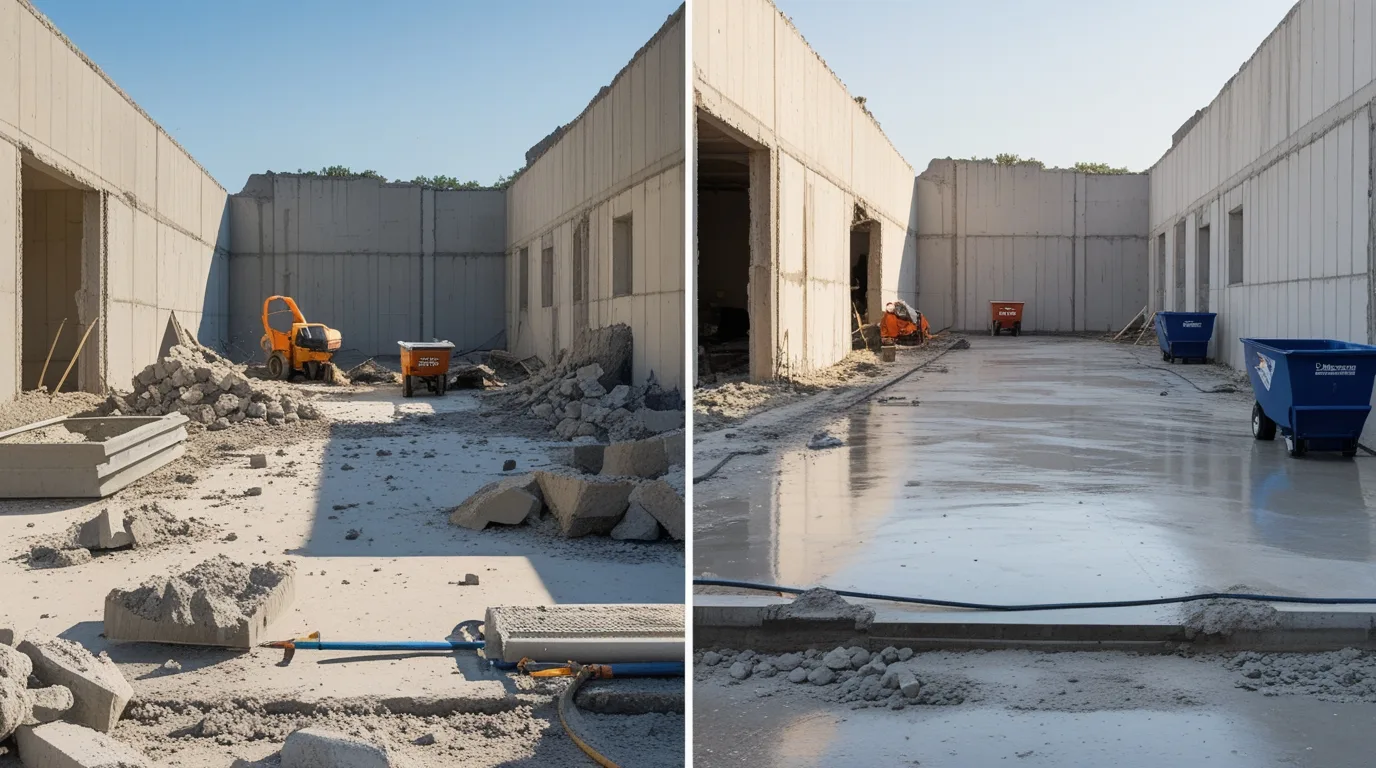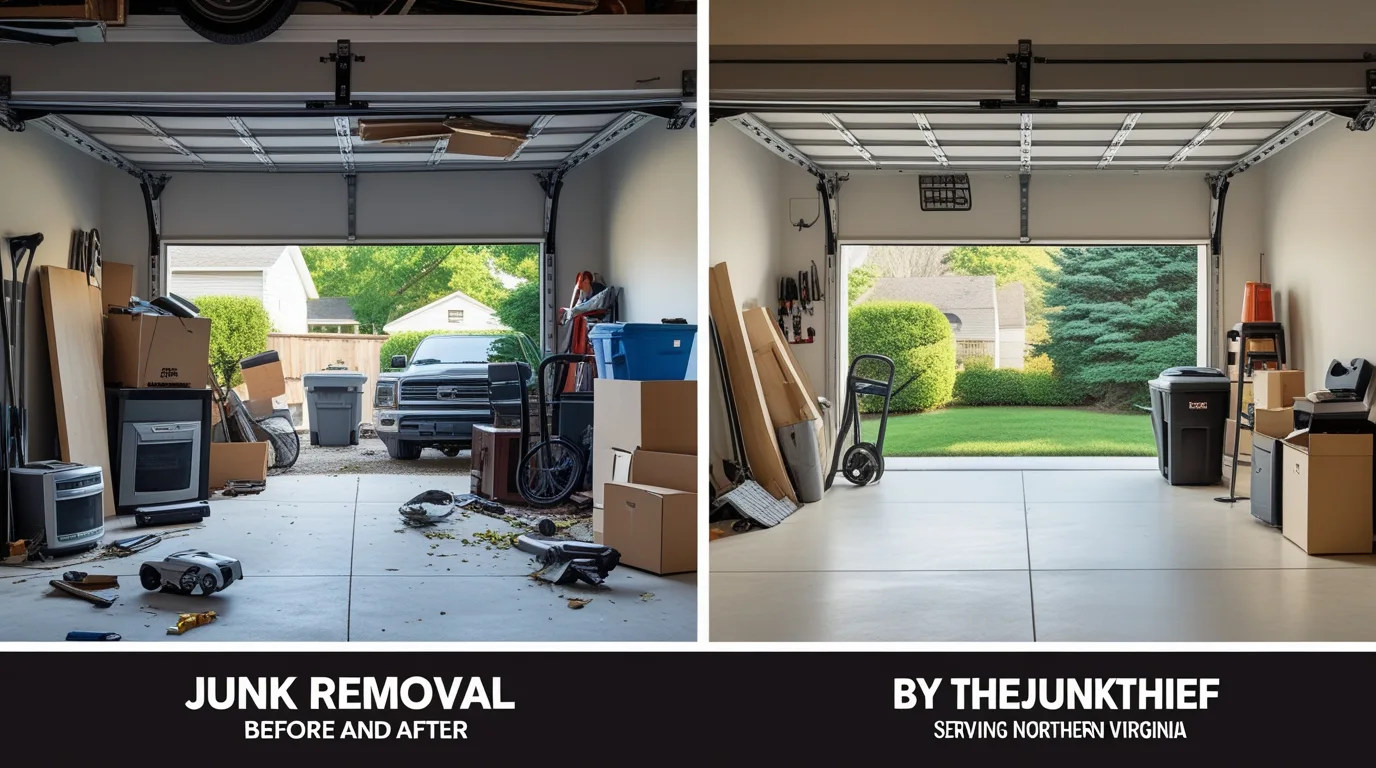Breaking Down the Mess: Why Demolition Removal Matters
Every big change starts with a mess. Whether you’re tearing down a wall, removing an old patio, or clearing a job site, one thing is certain: there’s going to be a lot to clean up. That’s where demolition removal comes in. It’s easy to focus on the demolition itself, but what happens next is just as important. You need someone to clean up what’s left behind, piles of debris, broken concrete, twisted metal. Without proper removal, a demolition site becomes unsafe. People can trip, equipment gets blocked, and the job slows down. A clean site is safer, faster to work on, and looks more professional. That’s why demolition and removal services matter just as much as the demo itself.
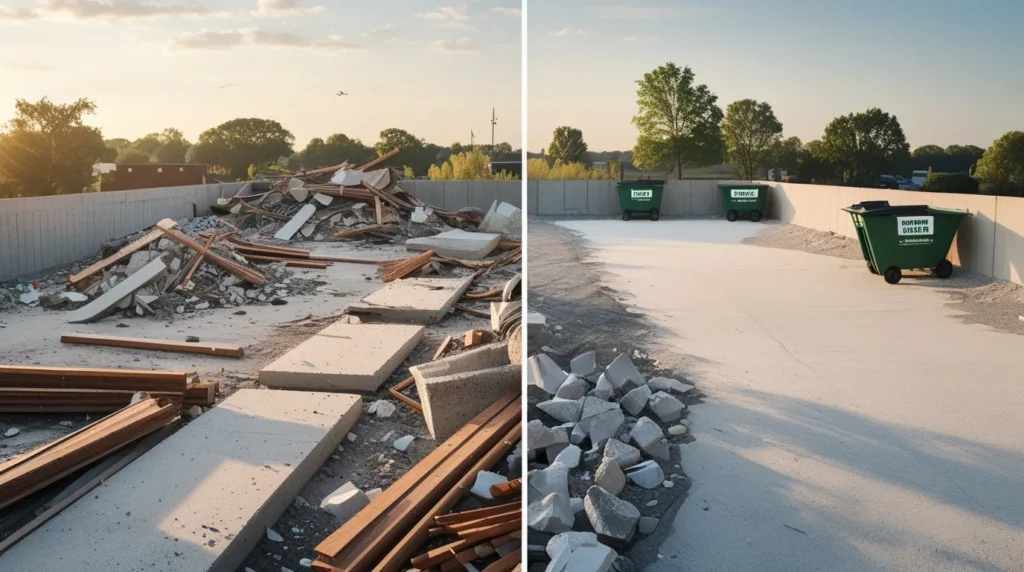
From Wreckage to Clean Slate: What Happens After Demolition
Once the dust settles, it’s time to clean up. And that’s not as simple as sweeping the floor.
After a building is torn down or a structure is removed, what’s left behind isn’t always easy to handle. There can be heavy slabs of concrete, wood, old piping, and sharp metal pieces. Some materials may need to go to recycling centers. Others have to be safely hauled to disposal facilities. This is where a skilled team makes a big difference. They sort out what can be reused or recycled and haul away the rest. Post demolition cleanup helps prepare the space for what comes next, whether that’s a rebuild, a new concrete pour, or just a clear, open yard.
It’s not just about cleaning up. It’s about making the space safe, tidy, and ready to go.
Inside a Demolition Site: What Needs to Be Removed?
Every demolition site is different, but many have the same types of debris. Knowing what needs to go helps workers prepare and avoid delays.
Here’s what you’ll usually find:
- Demolished concrete: This could be slabs, chunks from walls, or broken sidewalks.
- Wood framing and drywall: Left from walls, ceilings, or floors.
- Metal pieces: Screws, rods, or parts of support beams.
- Old flooring or tiles: Often heavy and full of dust.
- Glass and window frames: Fragile and must be handled with care.
- Roofing materials: Shingles, nails, and tar paper are common.
Removing all this takes more than a broom and a trash can. That’s why pros use dumpsters, tools for concrete removal, and proper safety gear. It’s a job that takes planning, strength, and skill.
Concrete Demolition and Removal Explained Simply
Concrete is tough. That’s what makes it great for driveways, patios, and buildings. But when it’s time to take it out, things get tricky.
Concrete demolition and removal means breaking large, heavy slabs into smaller pieces so they can be hauled away. This often includes using heavy-duty tools like jackhammers or saws. For larger projects, crews may bring in machinery like skid steers or mini excavators. Once the concrete is broken up, it’s loaded into dumpsters or trucks. Some concrete is sent to recycling facilities where it’s crushed and used again in new construction projects. Other times, it’s disposed of in special debris sites.
Proper concrete cutting and removal takes time and experience. Rushing it or using the wrong tools can be dangerous or damage nearby areas.
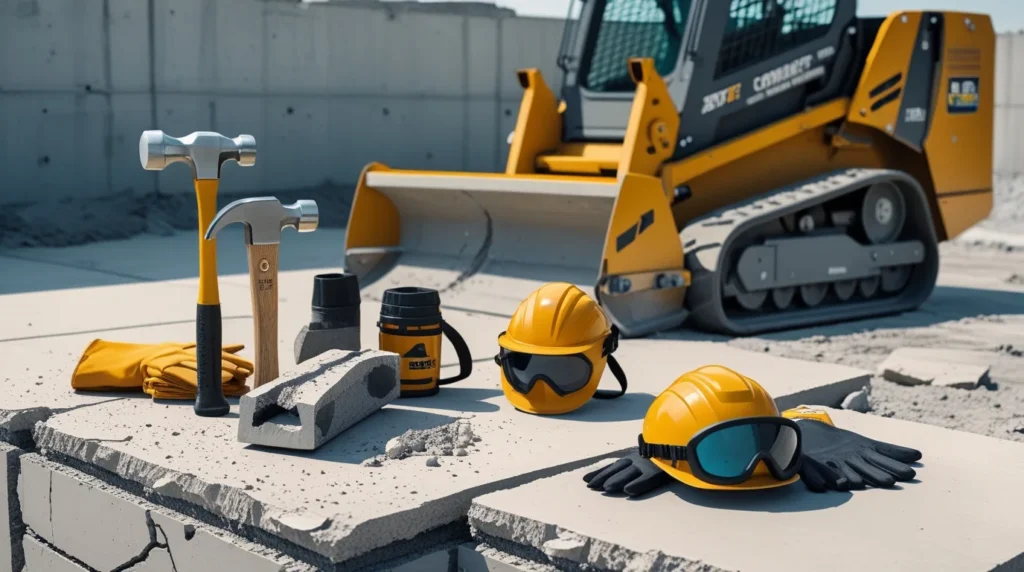
Tools and Techniques for Safe Concrete Tear-Out Jobs
So, how do professionals remove concrete safely and efficiently? It starts with the right tools.
Here are some of the most common tools for concrete removal:
- Jackhammers: Break up slabs into manageable chunks.
- Concrete saws: Cut straight lines through thick surfaces.
- Sledgehammers: Still useful for small or thin areas.
- Skid steers: Scoop and haul heavy loads.
- Dust masks and safety gear: Always used to keep workers safe.
The technique matters too. Workers often score the surface with a saw before breaking it up. This helps control the size of the pieces and reduces the chance of cracks spreading too far. Safety is always the top priority. Using the right tools means the job gets done faster and without damage. That’s why most people hire a concrete removal contractor instead of doing it themselves.
When to Call the Pros: Signs You Need a Concrete Removal Contractor
Not all jobs can be handled with a sledgehammer and a weekend. Here’s when you should think about calling in a professional:
- The slab is thick or reinforced with steel bars.
- You’re working near pipes, wiring, or other structures.
- It’s part of a large demo and removal project.
- You don’t have the tools or time to do it right.
- You’re concerned about safety, yours or others’.
Contractors know how to work around tricky spaces, avoid costly mistakes, and haul away debris the right way. They’re also insured, trained, and often have access to better tools.
When in doubt, hiring a professional saves time, money, and stress.
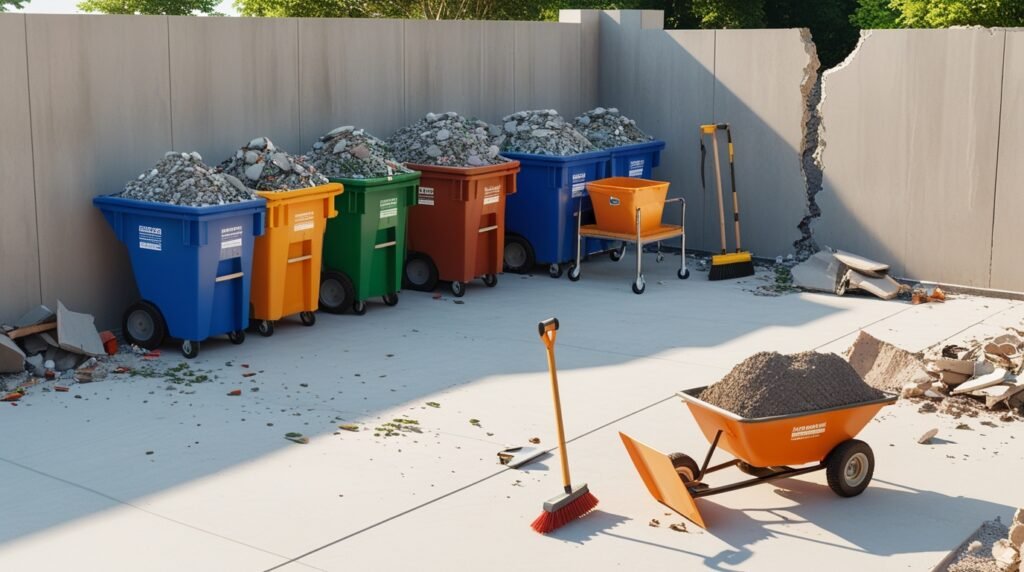
Cost-Effective Demolition Clean Up Without Cutting Corners
Everyone wants a clean site, but no one wants to overspend. Luckily, cheap concrete removal doesn’t mean poor quality if you know what to look for.
The best way to stay on budget is to hire a service that offers:
- Free quotes
- Clear pricing with no hidden fees
- Flexible scheduling
- Efficient tools and experienced crews
At the Junkthief, we believe in making the process simple and affordable. Whether you’re clearing a garage, prepping for a patio redo, or managing a small construction project, our team brings the right approach at a fair price.
Remember: cutting corners during clean-up often costs more later. Broken glass, hidden nails, or leftover debris can damage tires, injure workers, or slow the next step in your project.
Concrete Demo and Removal: The Post-Demolition Process
Once the tearing down is done, the cleanup begins.
The concrete demo and removal process usually follows this path:
- Break up the material: Using saws, jackhammers, or heavy machines.
- Sort the debris: Recyclables, landfill waste, and possible donations.
- Haul it out: Using dumpsters or trucks.
- Clean the site: A final sweep to remove dust, nails, and small debris.
The team also checks for any leftover demolished concrete that might have fallen outside the main area. The goal is to leave the site better than they found it, clean, safe, and ready for what’s next. When done right, post-demolition work blends speed with safety. That’s what sets good teams apart from the rest.
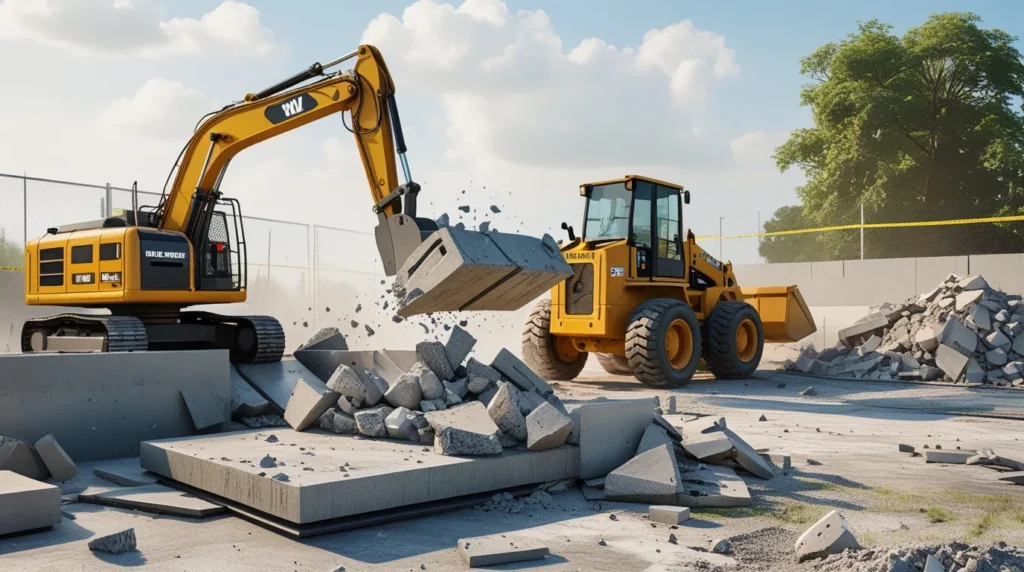
How Demolition by Machines Speeds Up Cleanup
In some jobs, machines do the heavy lifting literally. Demolition by machines is the fastest way to tear down and clear out large spaces.
Machines used in demolition include:
- Excavators with concrete crushers or shears
- Skid steers for smaller debris hauling
- Bulldozers to push material into piles
This type of work is usually needed for commercial jobs, large site demolitions, or properties with big concrete areas. It’s faster and safer than doing everything by hand, but it also takes skill. Operators must know how to move large pieces without damaging pipes, wires, or nearby buildings. That’s why machine-based cleanup is best left to trained crews.
Local Focus: Professional Demolition Removal in Northern Virginia
In Northern Virginia, local projects need local know-how. That includes everything from understanding city cleanup codes to choosing the right disposal sites. When you work with a trusted local team like The Junk Thief, you’re getting more than just labor. You’re getting experience. We understand what homes and businesses in the area need and how to deliver clean, safe demolition removal every time.
From small backyard jobs to full site clean-ups, our goal is simple: fast, responsible service that clears the way for your next big step.
Ready for a Clean Start? Let’s Clear It Out
Demolition makes way for something new, but the mess left behind can slow everything down. Whether you’re dealing with concrete slab demolition, tearing out old steps, or cleaning up after a full structure removal, it’s a job that needs to be done right. Professional demolition and removal services make the process easy. From hauling away heavy concrete to sweeping up fine dust, the right team keeps your project on track and your space ready for whatever comes next.
Looking for fast, safe, and affordable help? Get in touch with the Junk Thief today and take the first step toward a clean start.

